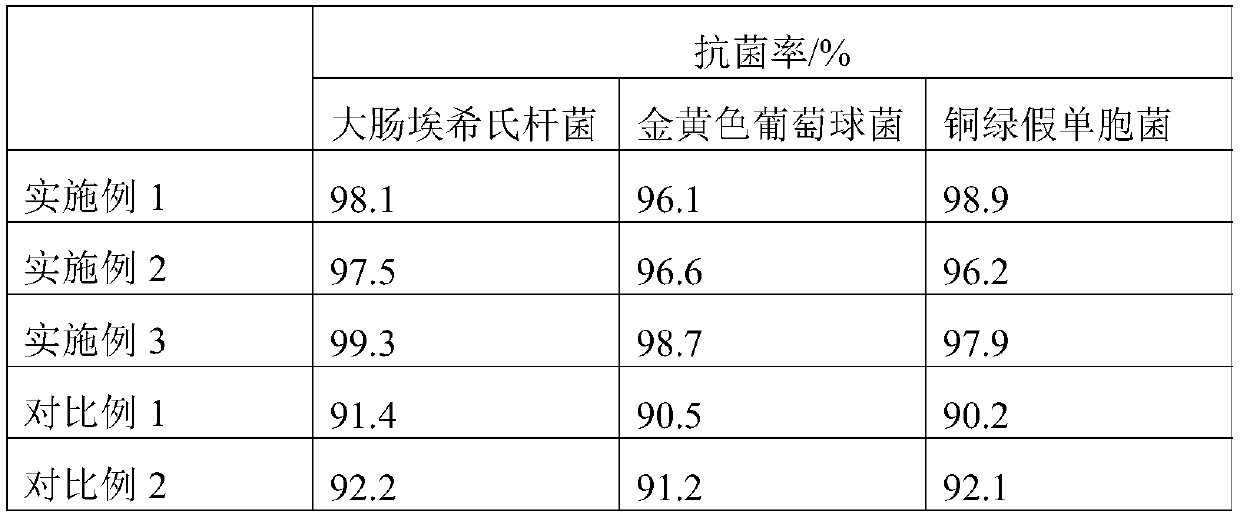Antibacterial agent and wood-plastic composite material
A technology of wood-plastic composite materials and antibacterial agents, which is applied in the field of wood-plastic composite materials, can solve problems such as affecting the performance and life of the wood-plastic composite material, degrading the wood-plastic composite material, and the hazards of the wood-plastic composite material, so as to improve the surface effect and enhance the interface effect , the effect of improving compatibility
- Summary
- Abstract
- Description
- Claims
- Application Information
AI Technical Summary
Problems solved by technology
Method used
Image
Examples
Embodiment 1
[0045] The wood-plastic composite material includes in parts by weight: 80 parts of PVC resin, 35 parts of wood powder, 15 parts of calcium carbonate, 35 parts of synergist, 1 part of foaming agent, 10 parts of stabilizer, 2 parts of coupling agent, processing aid 6 parts of lubricant, 4 parts of lubricant, 1 part of antibacterial agent;
[0046] Wherein, the antibacterial agent includes: shell: the shell component is organosilicon quaternary ammonium salt; middle layer, the middle layer component is polyhexamethylene guanidine hydrochloride; inner core. The inner core component is isothiazolinone; and, the particle diameter of the antibacterial agent is: D50<5 μm, D90<12 μm. The weight ratio of the organosilicon quaternary ammonium salt, polyhexamethyleneguanidine hydrochloride and isothiazolinone is 5:3:2.
[0047] Described calcium carbonate is heavy calcium carbonate.
[0048] The stabilizer is a calcium zinc stabilizer.
[0049] The lubricant is paraffin.
[0050] The...
Embodiment 2
[0054] The wood-plastic composite material includes in parts by weight: 120 parts of PVC resin, 15 parts of wood powder, 35 parts of calcium carbonate, 15 parts of synergist, 1 part of foaming agent, 10 parts of stabilizer, 1 part of coupling agent, processing aid 10 parts of lubricant, 2 parts of lubricant, 3 parts of antibacterial agent;
[0055] Wherein, the antibacterial agent includes: shell: the shell component is organosilicon quaternary ammonium salt; middle layer, the middle layer component is polyhexamethylene guanidine hydrochloride; inner core. The inner core component is isothiazolinone; and, the particle diameter of the antibacterial agent is: D50<5 μm, D90<12 μm. The weight ratio of the organosilicon quaternary ammonium salt, polyhexamethyleneguanidine hydrochloride and isothiazolinone is 5:3:2.
[0056] Described calcium carbonate is light calcium carbonate.
[0057] The stabilizer is an organotin stabilizer.
[0058] Described lubricant is stearic acid.
...
Embodiment 3
[0063] The wood-plastic composite material includes in parts by weight: 100 parts of PVC resin, 25 parts of wood powder, 25 parts of calcium carbonate, 25 parts of synergist, 2 parts of foaming agent, 7.5 parts of stabilizer, 1.5 parts of coupling agent, processing aid 8 parts of agent, 3 parts of lubricant, 2 parts of antibacterial agent;
[0064] Wherein, the antibacterial agent includes: shell: the shell component is organosilicon quaternary ammonium salt; middle layer, the middle layer component is polyhexamethylene guanidine hydrochloride; inner core. The inner core component is isothiazolinone; and, the particle diameter of the antibacterial agent is: D50<5 μm, D90<12 μm. The weight ratio of the organosilicon quaternary ammonium salt, polyhexamethyleneguanidine hydrochloride and isothiazolinone is 5:3:2.
[0065] Described calcium carbonate is the mixture of heavy calcium carbonate, light calcium carbonate, complex calcium carbonate.
[0066] The stabilizer is a mixtur...
PUM
 Login to View More
Login to View More Abstract
Description
Claims
Application Information
 Login to View More
Login to View More - R&D
- Intellectual Property
- Life Sciences
- Materials
- Tech Scout
- Unparalleled Data Quality
- Higher Quality Content
- 60% Fewer Hallucinations
Browse by: Latest US Patents, China's latest patents, Technical Efficacy Thesaurus, Application Domain, Technology Topic, Popular Technical Reports.
© 2025 PatSnap. All rights reserved.Legal|Privacy policy|Modern Slavery Act Transparency Statement|Sitemap|About US| Contact US: help@patsnap.com

